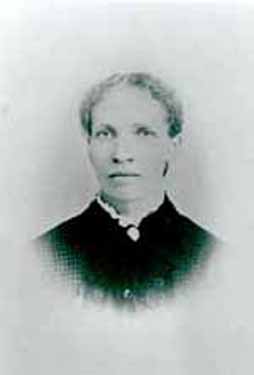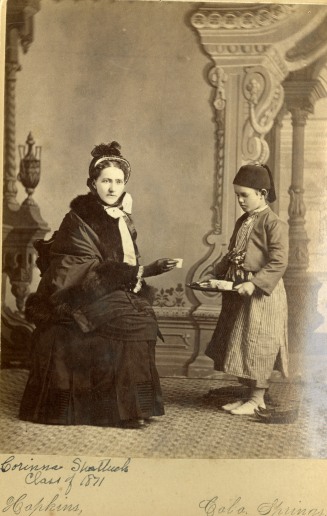
Our Connection to Tuskegee; Olivia A. Davidson, Co-founder and Educator
Olivia A. Davidson is a celebrated alum from Framingham State’s past. Born on June 11, 1854 she lived her first years of life in Mercer County, Virginia. Her father, Elias Davidson, was a freed slave and her mother, Eliza Webb, was a free black woman. The Davidson family moved to Ironton, Ohio when Olivia was three years old. It was in Ohio that Davidson received her teaching certificate at fifteen before beginning her teaching career a year later.
Hearing of need for teachers in the southern parts of the country Davidson moved south. She taught in Spencer, Mississippi and Memphis, Tennessee. One of the most notable moments of her character occurred while she was in Mississippi. One of her students came down with a case of smallpox, and Davidson closed her school to personally care for the boy until he was healthy. In Memphis she was one of the original eight teachers who taught at the Clay Street School when it opened on March 13, 1874. The school was designated for children of color and was the first brick school building in Memphis. Due to controversies surrounding the principal Davidson left the school and went on to further her own education. Upon her return to Ohio she learned of an outbreak of yellow fever, and while she asked to return as a nurse for the sick, she was denied due to never having the disease herself. Instead, she went on to the Hampton Institute, now known as Hampton University, located in Virginia.
She entered the Institute in 1878. Davidson’s tuition was paid for by Lucy Hayes, the wife of President Rutherford B. Hayes. Due to her already impressive teaching career she was enrolled as a senior and graduated a year later with honors. She delivered one of ten speeches given by students on that day. During her brief time there, Davidson also garnered the interest of Mary Hemenway, a wealthy philanthropist from Boston with a very familiar name. It was Hemenway who convinced Davidson to continue in higher education by attending the Framingham Normal School.
Before moving to the North, Davidson was told that her skin was light enough she could pretend to be a white woman and enjoy the privileges thereof. Reportedly, she refused to do so because she felt no shame in her race. Instead, she wanted to honor her people and demonstrate what an African American woman could accomplish. With her head held high, and her dignity as a black woman intact, Davidson started in Framingham on September 3, 1879 at the age of 25. Mary Hemenway paid for her expenses. She graduated two years later on June 29, 1881 as one of six honors students in her class of twenty-five graduates. She held highest honors.
Through her six years of teaching before higher education and her own academic accomplishments, Olivia Davidson became a well-respected woman in the academic community. Booker T. Washington delivered a speech during her graduation from the Hampton Institute, and upon her graduation from Framingham he reached out to her about a new project he was working on—the Tuskegee Institute. Washington asked her to join him in the founding of a school for black education, and she agreed but needed a few months to regain her health. By the end of the summer of 1881 they were working together to build the school from the ground up.
Davidson’s contributions have been overshadowed by Washington’s own fame, but he has noted her accomplishments in his autobiography Up From Slavery. He wrote, “No single individual did more toward laying the foundations of the Tuskegee Institute so as to insure the successful work that been done there than Olivia A. Davidson.” She tirelessly worked as a teacher and the first Assistant Principal to bring Tuskegee into fruition. Some of her most notable work came from her fundraising efforts. Aside from local festivals where she encouraged the community to make any sort of donation they could—money, food, or even animals—Davidson also went on several trips a year to the North. She had accumulated many wealthy peers who she counted on to donate to the school; Mary Hemenway was always a happy contributor. Her fundraising successes allowed Tuskegee to secure its permanent location and grow into what it is today.
In 1886, Davidson married Booker T. Washington after his first wife, Frannie (Smith) Washington, passed away two years prior. They were married at her sister’s house in Athens, Ohio on August 11. Davidson gracefully took on the roles of wife and step mother on top of her other duties at Tuskegee. She helped raise Portia Washington as if she were her own daughter, and gave birth to Booker Jr. on May 29, 1887 and Ernest Davidson on February 6, 1889.
Olivia Davidson died that same year her second son was born. Two days after Ernest arrived, their home caught fire due to a faulty flue. The family was not harmed, but Davidson never recovered from the exposure to the morning cold. She was moved to Montgomery and then to Boston for treatment before she died on May 9, 1889 due to tuberculosis of the larynx. Her loss was felt by every person she influenced, from her family in Ohio, to her students at Tuskegee, and her friends in Framingham and Boston.
Today we honor Olivia Davidson and recognize her stunning efforts in education for people of color. She overcame illness, racism, and great financial odds to help cultivate a place to nurture the next generation at great personal cost. As students we should all aspire to have the same work ethic as Olivia Davidson, and strive to make such an impact on the world.
Ryan Toomey – English Intern 2017




